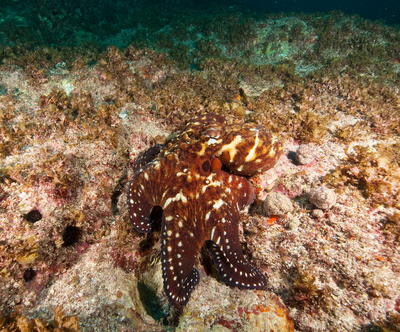Blue-lined Octopus
Hapalochlaena fasciata
This small octopus grows to about 15 cm in armspan, but is often much smaller. It is easily recognised by the iridescent blue lines on the body and linked blue rings on the arms and webs, however this is a warning colouration and only obvious when the animal is aggravated. When at rest the Blue-lined Octopus is well camouflaged, being drab mottled brown, without the blue lines visible. It feeds on crabs and other crustaceans on intertidal and subtidal rocky reefs and under dead coral, sponges, or mussel clumps on sandy-mud flats. The Blue-lined octopus lives in rock crevices or frequently in dead shells, such as those of the razor clams (Pinna spp.). While most active at night, it also forages in rock pools during day-time low tides. This species is highly toxic. The venom is produced by bacteria housed in the salivary glands of the octopus, and injected into the prey through a bite from its small parrot-like beak. It is responsible for at least one human death, where voluntary muscles are paralysed, so while the heart continues to beat, death is caused by breathing failure. Treatment involves expired air resuscitation (EAR or mouth-to-mouth) and transport to respirators that will keep the patient alive until the toxin wears off (24 hours or more). There are no known long-term side effects.
This species is only found from southern Queensland to southern NSW.




